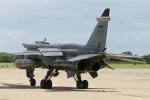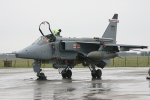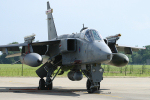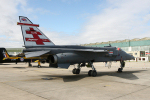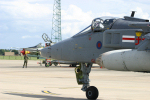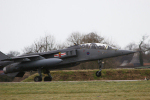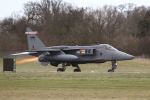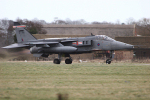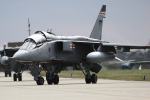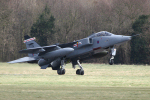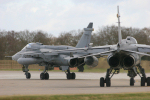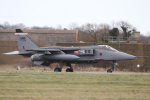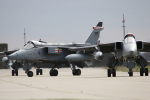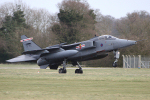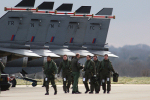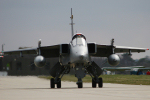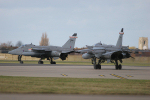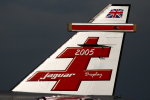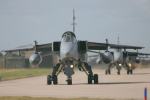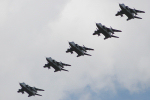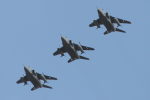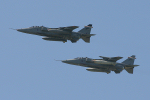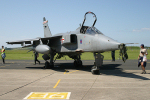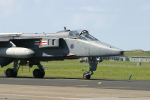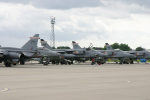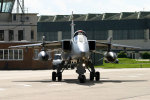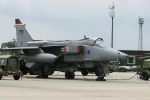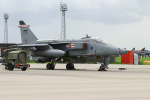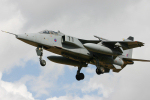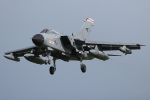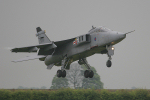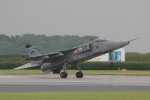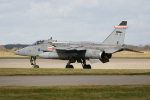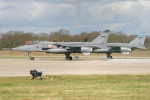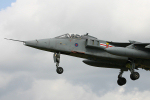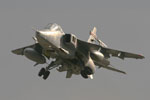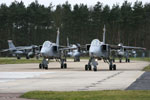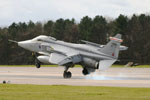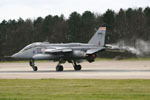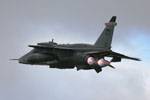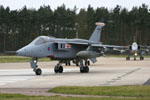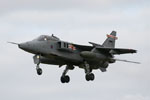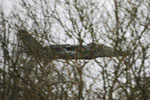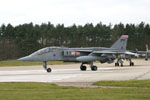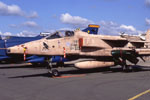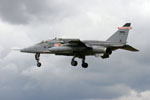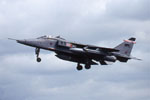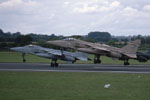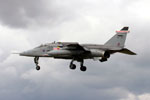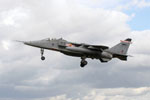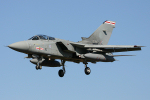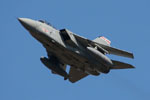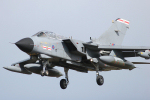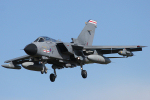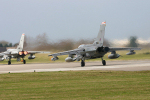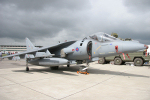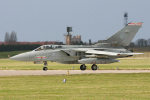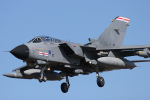Formed
at Gosport in July of 1916 as part of the Royal Flying Corps, 41 Squadron
were soon moved to Saint Omer in the Nord-Pas de Calais region of Northern
France and were to join the war effort on the Western Front. Staying
in France until the end of the war, the unit moved from their original
FE.8s to the DH.5 and then, in December 1917, they transitioned onto
the well regarded SE.5a. The DH.5, used by 41 Squadron for about six
months, proved to be somewhat of a flop thanks to an inadequate engine
and, by the end of 1917, the DH.5 was removed from front-line duties
and re-tasked as a trainer. The extra power offered by the SE.5a enabled
the 97mph maximum speed of the FE.8 to be bettered by more than 30mph.
Another advantage was that the SE.5a had a service ceiling that was
almost 5,000ft higher than the FE.8 and was the equal of, or superior
to, anything the Germans could field. |
|
|
After
the end of the war, 41 Squadron remained on European soil until they
relocated to Tangmere, near Chichester, in February of 1919 where they
were then disbanded when Tangmere was closed (what’s that about
history repeating itself?). Four years later, again on April 1st, 41
Squadron was reformed at RAF Northolt as a fighter squadron and were
initially assigned Sopwith Snipes. The Snipe was pretty much an upgraded
relative of the company’s Camel which, compared to the Camel,
gave the pilot greater visibility, a much better rate of climb and was
said to be easier to fly even though it was very much on a par with
the Camel in terms of service ceiling and maximum speed. Even though
the Bently BR.2 engine was up to 120hp more powerful than the Bentley
BR.1 or Clerget 9B engines fitted to the Camel, an empty Snipe was more
than 200kg heavier than the Camel. |
A year later, the Snipes were relegated to the squadron’s history books as the unit moved onto the Armstrong-Whitworth Siskin III. Based on the older Siddeley Siskin SR.2, the Siskin III was the RAF’s first all-metal fighter to reach production and after about three years with the Siskin III, the squadron was assigned the more powerful Siskin IIIAs in March of 1927. The IIIAs, whilst still making use of a Rolls-Royce engine, were fitted with the improved Jaguar IV engine which provided an impressive 385 horses compared to the 325 of the earlier Siskin IIIs powerplant. The upshot being that the Siskin IIIA could fly faster and higher than anything that 41 Squadron had used previously. Keeping Siskin IIIAs until late 1931, they then gave way to Bulldog IIAs. The Bulldog proved to be cheap to maintain and during the era of reduced defence expenditure in 1930s Britain it rapidly became the most widely used aircraft in the RAF. The Bulldog also has the somewhat dubious distinction of being the type in which Douglas Bader lost his legs after crashing at Woodley airfield whilst conducting an aerobatic display. |
|
|
In
July 1934, 41 Squadron transitioned onto yet another aircraft type –
their mounts following this particular transition were to be Hawker
Demons. The Demon was basically a dedicated fighter version of the two-seat
Hawker Hart light bomber and was actually initially called the “Hart
Fighter”. The Demons were equipped with three .303 machine guns
with one of them being mounted in the rear cockpit in a powered gun
mount, the other two in the forward fuselage. Performance wise, the
Demon could top 180mph and had a service ceiling of roughly 28,000ft.
In October of 1935, 41 Squadron deployed to the warmer climes of Aden
and was tasked with combat air patrols during the Abyssinian Crisis.
Less than a year later, in August 1936, 41 Squadron returned to the
UK and in October of 1937 moved onto yet another type – they would
receive what some class as the finest biplane fighter ever built, the
Hawker Fury II. The Fury II was the first operational RAF fighter to
exceed 200mph in level flight and was built primarily for interception
– the result being a Fury II had an impressive climb rate of almost
2,500ft/min and a maximum ceiling of nearly 30,000ft. Compared to previous
aircraft, with just two guns the Fury came up a little short on firepower
although the great performance made up for any small inadequacies on
the arsenal front. |
The
people of St Omer then honoured the squadron by granting permission
for ‘their’ double-barred cross, which featured in their
town’s coat of arms, to be incorporated into the squadron badge
and, ever since King George VI approved the design and “Seek and
Destroy” motto in February of 1937, this quite recognisable cross
has featured in the markings worn by the squadron’s aircraft.
The Fury IIs remained on strength until early 1939 when they transitioned,
yet again, onto arguably one of the greatest fighters of all time –
the Supermarine Spitfire. 41 Squadron were one of the very few units
to remain as a Spitfire outfit for the entire duration of the war although
they did move onto the latest types as they became available. Operations
with Spitfire Mk Is were first conducted from RAF Catterick and it is
from Catterick that a 41 Squadron Spitfire I launched on a mission that
saw “first blood” for both 41 Squadron and England-based
Spitfires when a Heinkel He-111 long-range medium bomber was shot down
off the North Yorkshire coast. In May of 1940 the squadron moved south
to Hornchurch in Essex, where they provided valuable air cover for the
Dunkirk evacuation; following the evacuation, the squadron moved the
200 miles north to Catterick where they would stay until early September
when they again moved back down south to Hornchurch to relieve 54 Squadron.
Had 41 Squadron been collecting Air Miles, most pilots would probably
have amassed quite a sizeable quantity! During 1940 and assigned to
12 Group, 41 Squadron’s Spitfire Is and more powerful IIAs did
their bit in the Battle of Britain to help their almost besieged colleagues
of 11 Group and together they stopped the Luftwaffe from gaining what
would have been vital air superiority over South East England. |
|
|
In
1941 and 1942, 41 Squadron mounted offensive sweeps from a number of
British bases and even provided vital aerial support for the Dieppe
Raid in August 1941 with their new Spitfire Vbs. The intention of this,
sometimes referred to as “The Raid on Dieppe” or “Operation
Jubilee”, was to seize the German-occupied port of Dieppe in order
to ‘scare’ them into strengthening defences in the west
at the expense of various other points. However, this operation is generally
considered to have been a complete failure – more than ?rds of
the infantry were killed and the air element lost more than 100 aircraft.
Although it could be argued many of the lessons learnt reappeared in
the amphibious assaults in North Africa and, eventually, Normandy. A
few months later, in February of 1942, 41 Squadron launched missions
in support of operations against three major German warships (the battle
cruisers Scharnhost and Gneisenau and the heavy cruiser Prinz Eugen)
that had made a dash for safety from Brest back to Germany. |
In
February 1943, 41 Squadron beat 91 Squadron to become the first squadron
to operate the Spitfire XII – the first Spitfire type fitted with
the 1815hp Griffon VI engine. Only one hundred were produced yet, unlike
the earlier Spitfire Vbs, they proved to be quite superior to the Focke-Wulfe
FW190s operated by the Luftwaffe. Together with 91 Squadron, and based
at RAF Westhampnett, 41 Squadron formed a “bomber support wing”
with the Spitfire XIIs to escort Hawker Typhoons and 2 Group’s
heavy bombers into continental Europe. During the latter war years,
41 Squadron Spitfires were employed against targets in northern France,
German bombers and eventually tasked with defending against V1 flying
bombs as part of Operation Crossbow. In September of 1944, the squadron
underwent yet another transition – on to the Spitfire XIV –
and moved to the continent. 41 Squadron, by now flying Tempest Vs, were
officially disbanded by a simple renumbering exercise on 1st April 1946
and were renumbered as 26 Squadron. However, that very same day saw
122 Squadron at RAF Dalcross renumbered as 41 Squadron and was moved
down south to RAF Wittering. |
|
|
After
the spell with the Spitfire XXI, the squadron was retasked as 12 Group’s
instrument flying training unit at RAF Church Fenton and operated the
Harvard T.2B and Oxford T.2 in the training role. Ten months later in
June 1948, the squadron reverted back to a fighter squadron and swapped
the Harvards and Oxfords for de Havilland DH.103 Hornets, a long range
fighter which looks very much like a Mosquito. As well as sharing more
than a passing resemblance to the “Mozzy”, the Hornet shared
a few family traits too. It was quick - very quick. Being able to reach
a speed of 485mph, the Hornet was the fastest piston engined aircraft
in the RAF, the fastest twin-propeller aircraft ever flown anywhere
and the fastest wooden aircraft in the world. 41 Squadron had begun
Hornet operations with the F.1 version and ended the association with
the Hornet with the longer-legged F.3 variant. Just three years after
receiving the Hornet F.1, in early 1951, the Hornet was gone and 41
Squadron received their first jet powered aircraft – the Gloster
Meteor – and moved to Biggin Hill a few months later to provide
air defence cover for London. Initially flying the 585mph F.4 the squadron
moved onto the F.8 which was basically an F.4 with a longer nose to
provide better stability and greater fuel capacity. In 1955, the Meteor
F.8s were exchanged for Hunter F.5s. The F.5 was basically an F.4 with
a Sapphire Mk 101 engine and also the first Hunter type to see combat
service during the Suez campaign. After operating Hunters for roughly
2½ years, 41 Squadron were disbanded on the 31st of January 1958.
However, 141 Squadron were re-numbered 41 Squadron on the 1st of February…
yes, just one day later the squadron was active again. |
The renumbering exercise meant that 41 Squadron were basically 141 Squadron by any other name and inherited the Coltishall-based Gloster Javelin FAW.4s that 141 Squadron received whilst at RAF Horsham St Faith when Coltishall underwent runway work. The tasking for the Javelin fleet was basically to intercept, in all weathers (hence the AW bit of FAW) any Russian bomber force that was headed for the UK. After two years, the FAW.4 was replaced by the FAW.5 and then three years after that, the FAW.8 took over. The FAW.5 was externally similar to the FAW.4 but had a revised wing design which allowed for the carriage of more fuel and had provision for four underwing Firestreak AAM pylons. The FAW.8 was essentially a FAW.7 with a slightly different wing design and had afterburners fitted to the Sapphire Sa.7 engines (forming the Sapphire Sa.7R). The Javelins of 41 Squadron continued to defend our skies until early December of 1963 when the squadron was once again disbanded. Air defence courtesy of 41 Squadron re-appeared in September 1965 but this time round, there were no pilots... the squadron was equipped with Bloodhound Mk II SAMs and based at RAF West Raynham. As the Bloodhound was predominantly used as a last line of defence for the V-bomber force, after the Royal Navy took over the strategic deterrent role with the Polaris in 1968, all UK based Bloodhounds were withdrawn from service and put into storage or re-deployed to defend RAF Germany airfields. During this re-assessment of the Bloodhound force, 41 Squadron were once again disbanded. |
|
|
Less
than two years later, in April 1972, 41 Squadron markings were again
to be seen on a jet powered aircraft ...the mighty McDonnell Douglas
F-4M Phantom, named FGR.2 in British service. Stood up at RAF Coningsby,
the squadron specialized as a tactical reconnaissance unit, with a secondary
ground attack role, under the control of 38 Group Air Support Command.
Due to various political shenanigans, the FGR.2s were powered by Rolls-Royce
Speys which meant the initial RAF Phantoms were limited to a maximum
speed of less than Mach 1.9 and compared to the J79 powered “originals”,
the FGR.2 procurement ended up costing a fortune! However, the Spey
was somewhat more powerful and more fuel efficient than the J79 - Spey
powered Phantoms also possessed better low-level performance and a greater
combat radius, two major advantages for a tactical recon aircraft, so
it wasn’t all doom and gloom for the F-4M. 41 (Designate) Squadron
at RAF Coltishall was equipped with the new Anglo-French Sepecat Jaguar
GR.1 and flew under that guise (independent of the 41 Squadron Phantoms
up at Coningsby) from 1st October 1976 to 1st April 1977. 41 Squadron
was disbanded on 31st March 1977 and 41(Designate) dropped the Designate
suffix when the unit was declared fully operational and ready for combat
as a reconnaissance unit with the Jaguar GR.1 on the 1st of April 1977.
In doing so, 41 Squadron became one of the last of nine squadrons to
operate the Jaguar, five of which were assigned to RAF Germany and were
based at Laarbruch and Bruggen – the other four, the only Jaguar
squadrons to not transition onto the Tornado, would eventually be consolidated
at Coltishall. |
In
February of 1978, 41 Squadron was integrated into Supreme Allied Commander
Europe’s Strategic Reserve (Air) and under the ultimate command
of SACEURs commander, an American four-star General. In 1983, the squadron
was assigned to the Allied Command Europe Mobile Force (AMF) which is
basically a small yet multinational rapid reaction force able to deploy
at short notice to any threatened region of Allied Command Europe. As
part of this Mobile Force and the potential tasking of it, 41 Squadron
have regularly taken their Jaguars to Bardufoss in the cold, icy and
snow covered climes of Northern Norway, 100 miles into the Arctic Circle.
1983 saw the GR.1s and two-seat T.2s upgraded to GR.1A/T.2A standard
when the NAVWASS navigation system was replaced by a Ferranti FIN1064
system; the GR.1As also received ALE-40 chaff & flare dispensers,
the ability to employ ECM pods and a self-defence ability courtesy of
AIM-9G Sidewinders. When Saddam Hussein invaded Kuwait in August 1990,
twelve jets and crews from all four Jaguar squadrons (the Germany based
units had all transitioned onto the Tornado by late 1988) were brought
together under 6(Composite) Squadron and deployed to Thumrait in Oman.
As the Omani 8 & 20 Squadron Jaguars are based there, maintenance
was simplified somewhat but later that year the RAF Jaguars were redeployed
to Muharraq, Bahrain to reduce the distances involved in flying to their
targets. This then obviously reduced the Jaguars reliance on tanker
support from the likes of the VC-10s and Tristars at King Khalid Airport,
Riyadh. However, these twelve cats didn’t particularly like the
hot and dusty desert so another twelve jets underwent hasty upgrades
that increased the thrust of the Adour 104 engines, upgraded the RWR
and allowed AIM-9Ls to be employed from new over-wing rails. 41(Composite)
Squadron was put together to take these twelve jets to war, arriving
in-theatre at Muharraq in late October and early November. |
|
|
When
Desert Storm was over, the 12-jet detachment (amongst the twelve jets
were Sadman, Mary Rose, The Guardian Reader, Diplomatic
Service, Johnny Fartpants, Buster Gonad, Katrina Jane, Fat Slags
and Debbie) had flown 618 missions totaling more than 900 flight
hours over forty-four days of combat and in doing so had dropped roughly
350 tons of bombs. Close Air Support and suppressing naval forces saw
more than 600 unguided 70mm rockets and nearly 10,000 rounds of 30mm
ammunition fired. By the middle of March 1991, the Muharraq Jaguar Detachment
was back home at Coltishall but only for six months before deploying
back to the Middle East to play a part in Operation WARDEN. Incirlik
AB, Turkey, became home to eight of Coltishall’s cats which would
help enforce a safe haven for the Kurdish people of Northern Iraq and
to additionally help enforce the no-fly zone north of the 36th Parallel.
41 Squadron was the only dedicated Jaguar reconnaissance squadron yet
personnel from both 6 and 54(F) Squadrons were involved in the deployment.
This vital humanitarian role was conducted until February of 1993 when
Harrier GR.7s took over. Later in 1993, the Jaguar force was called
in to help enforce UN Security Council Resolution 816 which prohibited
fixed and rotary wing flights over Bosnia-Herzegovina, to support UN
troops on the ground and to strike at targets that acted hostile towards
UN declared safe areas. Operating from the home of 36º Stormo at
Gioia del Colle in Italy, it is during this campaign that 41 Squadron
Jaguars became the first ever RAF aircraft to drop a bomb in anger over
Europe since the end of the Second World War. The target? A Bosnian-Serb
main battle tank. The result? One written-off tank and if anyone was
inside, they’d all have monumental headaches. Again the Jaguars
stepped aside for their VSTOL colleagues and, in August of 1995, the
Jaguars left Gioia and let the Harrier force take the reigns. |
A
few years later in November 1997, 41 Squadron took twelve Jaguars on
a two week deployment to the Egyptian air base of Cairo-West, the home
of 76 & 78 Squadron’s F-4Es, and became the first RAF visitors
to the country in 41 years. Upgrades to the Jaguars didn’t end
and in early 2000, 41 Squadron took delivery of the first GR.3A –
the GR.3 was an upgrade that meant all Jaguars had the “desert
modifications” of the twelve jets that fought in Desert Storm
together with a MIL-STD-1553 databus which would allow the jets to employ
TIALD pods although only a few GR.3s were truly TIALD-capable due to
that old chestnut again, the defence budget and there not being enough
money in the kitty to upgrade all the jets at once. The GR.3A took this
a step further by making all Jaguars TIALD and reconnaissance capable
and was also one of the first jets that had a helmet mounted sight system
– long before the JHMCS appeared on the likes of the F-15 and
F/A-18. The Jaguar system, whilst not exactly providing the functionality
of the JHMCS and AIM-9X, meant the pilot could, simply by moving his
or her head, target the TIALD pod, aim an AIM-9 or change what the recon
pod is looking at and taking pictures of. |
|
|
Jaguars
were expected to have one last combat swansong but Turkey refused permission
for any of its airbases to be used to attack Iraq – the result
being the Jaguars that were based at Incirlik to enforce the no-fly
zone in Northern Iraq were brought home before Operation TELIC began
in March 2003. The Jaguars at Coltishall were kept ready to go to war
in the skies over Iraq but they were never called upon to forward deploy
with their colleagues in 1 Group Strike Command / Air Combat Group.
As the Government announced the bringing forward of the Tranche 2 Typhoon
introduction (deliveries are to start in 2008), it was also announced
that Coltishall would be closed – two squadrons were disbanded
early in 2005, one of which was the Operational Conversion Unit. The
disbandment of the OCU saw all Jaguar conversion training taken up by
41 Squadron, more specifically, the Jaguar Training Flight embedded
within it and the last ever Jaguar pilot graduated from the JTF by mid-October
2005. Even though the Jaguars didn’t have a chance to sharpen
their teeth over Iraq, 41 Squadron had one last little bit of glory
– together with 6 Squadron, the unit took part in Exercise Excalibur
2005. Going up against the best in the business in Europe, 41 Squadron
did reasonably well in the competition with Flt Lt Mike “Sooty”
Sutton being the runner up in the 45º High Altitude Release bombing
and Flt Lt Alex “Tenno” Tennant took the #1 spot
in the 10º Low Altitude Load Drag bombing... if some questioned
whether or not, in an era of GPS guided this and laser guided that,
the Jaguars still had what it takes, well, Sooty and Tenno proved it
does. Maybe National Geographic knew more than they were letting on
when they said the Jaguar was, pound for pound, the strongest animal
in the world – here were 30 year old jets mixing it with jets
less than a third of their age, with newer systems and were beating
them! |
Time, as they say, never stands still and on the 29th of March 2006, most of the remaining Jaguars left RAF Coltishall for the last ever time to take up residency at RAF Coningsby. Whilst not quite the end of an era, it did signal that it was getting very close to game over for the Norfolk base and 41 Squadron. Three days later and it was all over bar the shouting – 1st April 2006 saw the Fast Jet & Weapons OEU (FJWOEU) officially take on the numberplate of 41(Reserve) Squadron and by the close of business on Saturday evening, all Coltishall had left as residents were two 29(R) Squadron Typhoons, a single 41(R) Squadron Harrier GR.9A and a lonely Jaguar GR.3A. They did go out in some degree of style though – Coningsby Jaguars amassed for one last diamond nine over their old home and, in addition, fully-marked 41(R) Squadron GR.4s, an F.3 and a GR.9 honoured their colleagues with a flypast over the Norfolk base too. On Monday, time really was called... the Typhoons and Harrier departed for home which left the aforesaid lone GR.3A to become the last ever Jaguar to fly from Coltishall – the home of the popular big cat for the last 31 and a bit years. Whether or not this was a carefully orchestrated stunt to ensure a Jaguar, and not a Typhoon or Harrier, was the last one out remains to be seen. It just wouldn’t have been “right” for Coltishall to have the lights turned out by anything other than a Jaguar. So, if it was a stunt, nice one! |
|
|
The
Jaguar force now consists of just 6 Squadron who have inherited 41 Squadron
personnel and will continue to fly the best sixteen Jaguars from Coningsby
until October 2007 when the crews move onto Typhoons with 6 Squadron
and XI(F) Squadron. The squadron itself, in terms of its colours and
markings, still lives on and will do so for the foreseeable future.
The FJWOEU low-viz grey jets now carry a splash of colour thanks to
the red and white 41(R) Squadron markings. Since 1916, 41 Squadron has
been called upon to provide air superiority, ground attack, anti-shipping
and reconnaissance to the theatres in which they were deployed –
as of 1st April 2006, the new mission is to conduct test and evaluation
of new/improved equipment, avionics or weapons in an operational environment.
Stood up at RAF Coningsby on 1st April 2004, the FJWOEU brought together
three units and merged them into one – Boscombe Down’s Strike
Attack OEU, RAF Valley’s Air Guided Weapons OEU and Coningsby’s
own Tornado F.3 OEU. Initially that meant that the one unit were quite
unique in the RAF as they were operating four types of front line jet
(Tornado GR.4, Tornado F.3, Harrier GR.7 & Jaguar GR.3A) which has
since dropped to three types with the removal of the Jaguar although
the unit also works closely with the Typhoon OEU, 17(R) Squadron. Whether
or not a fully-operational front line combat unit will re-take the squadron
numberplate at some point in the future and add to the impressive history
of 41 Squadron remains to be seen. |



